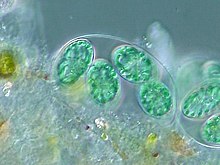Glaucocystis
| Glaucophyta | |
|---|---|
 |
|
| Glaucocystis sp. | |
| Scientific classification | |
| Domain: | Eukaryota |
| (unranked): | Archaeplastida |
| (unranked): |
Glaucophyta Skuja, 1954 |
| Class: |
Glaucophyceae Bohlin, 1901 |
| Order: |
Glaucocystales Bessey, 1907 |
| Family: |
Glaucocystaceae G. S. West, 1904 |
| Possible genera | |
| Synonyms | |
|
Glaucocystophyta Kies & Kremer, 1986 |
|
Glaucocystophyta Kies & Kremer, 1986
The glaucophytes, also known as glaucocystophytes or glaucocystids, are a small group of rare freshwater microscopic algae. Together with the red algae (Rhodophyta) and the green algae plus land plants (Viridiplantae or Chloroplastida), they form the Archaeplastida. However, the relationships among the red algae, green algae and glaucophytes are unclear, in large part due to limited study of the glaucophytes.
The glaucophytes are of interest to biologists studying the development of chloroplasts because some studies suggest they may be similar to the original algal type that led to green plants and red algae in that they may be basal Archaeplastida.
The chloroplasts of glaucophytes are known as 'cyanelles' or 'cyanoplasts'. Unlike the chloroplasts in other organisms, they have a peptidoglycan layer, believed to be a relic of the endosymbiotic origin of plastids from cyanobacteria. Glaucophytes contain the photosynthetic pigment chlorophyll a. Along with red algae and cyanobacteria, they harvest light via phycobilisomes, structures consisting largely of phycobiliproteins. The green algae and land plants have lost that pigment. Like red algae, and in contrast to green algae and plants, glaucophytes store fixed carbon in the cytosol.
Glaucophytes have with flat cristae, and undergo open mitosis without centrioles. Motile forms have two unequal flagella, which may have fine hairs and are anchored by a multilayered system of microtubules, both of which are similar to forms found in some green algae.
...
Wikipedia
